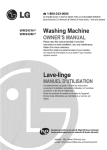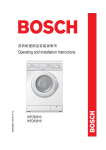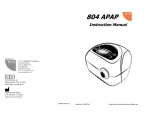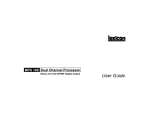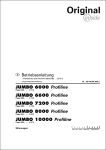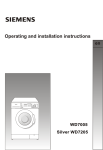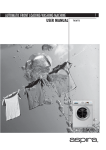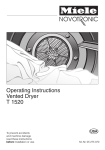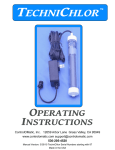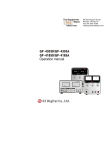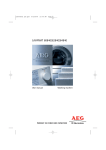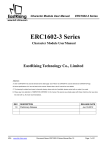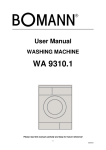Download Computer Controlled Slimline Frontloader Operating and Installation
Transcript
S Computer Controlled Slimline Frontloader Operating and Installation Instructions WM 1065 Family 1085 Silver 1095 en Please read this specification carefully before you use the product. Any failure and losses caused by ignoring the above mentioned items and cautions mentioned in the operation and installation instruction are not covered by our warranty and any liability. Please keep all documents in a safety place for future reference. If you have any doubt, please contact our local service center of dealer. If you need an English user manual, please download it from siemens web. Or you can send the E-mail to service department, or you can call up service hot line for free supply. Thanks! http://www.siemens-ha.com.cn [email protected] 4008899999 Table of Contents Disposal Information . . . . . . . . . . . . . . . . . . . . . .2 Operating Instructions Environmental Protection/Conservation Issues . .3 Safety Precautions and Warnings . . . . . . . . . . . . 4 Your New Washing Machine . . . . . . . . . . . . . . . . 6 Programmes and Functions . . . . . . . . . . . . . . . . 8 Laundry Detergents and Additives . . . . . . . . . . .10 First Wash Cycle . . . . . . . . . . . . . . . . . . . . . . . .12 Preparing, Sorting and Loading the Laundry . . .13 Washing . . . . . . . . . . . . . . . . . . . . . . . . . . . . . . 18 When the Programme has Ended. . . . . . . . . . . 20 Special Applications . . . . . . . . . . . . . . . . . . . . . 21 Cleaning and Care . . . . . . . . . . . . . . . . . . . . . . 23 Troubleshooting Minor Faults . . . . . . . . . . . . . .28 Customer Service . . . . . . . . . . . . . . . . . . . . . . . 31 Programme Table . . . . . . . . . . . . . . . . . . . . . . 32 Installation, Connection and Transport . . . . . . .33 Installation Instructions 1 Disposal Information , The new machine s packaging Your old machine 2 Dispose of packing materials in a responsible manner. Keep packing materials out of the reach of children. Packing materials are not toys. Reprocessing and re-using materials saves raw materials and reduces waste. All packing materials used are environment friendly and re-usable. Cardboard boxes consist of 80% to 100% recycled paper. Plastic wrappings are made from polythene(PE), the tapes are made from polypropylene(PP) and the CC-free packing is made from foamed polystyrene (PS). These materials are pure hydrocarbon compounds and can be recycled. Render the machine inoperable when it can no longer be used. Remove the plug from the socket and cut off the power cable. Destroy the catch on the porthole door. Prevent children at play from being locked in and risking death by suffocation. The old machine contains valuable materials which should be recycled. Please make your contribution to the environment by assisting with proper disposal or recycling. Environmental Protection Conservation Issues Through the economical use of energy,water and detergent,your appliance is kind to the environments as well as your household budget. You can increase the economy and environmental friendliness of your macnine by washing maxium loads: Cottons/coloureds: 5.2kg Easy-Care: 2.6kg Delicates/Wool: 2.0kg Single Wash: 3.5kg How to save energy: For small amounts of laundry,the automatic control system reduces the consumption of both water and energy. Where possible,use the 60 C Cottons/coloureds ,, programme with additional function Intensive instead of the 90 C Cottons/coloureds+prewash programme. This 60 C programme achieves a cleaning result comparable to that of the 90 C programme using considerably less energy. ,, Hints and tips How to save water,energy and detergent: Avoid using the Prewash function when washing lightly normally soiled laundry. How to save energy and time: For lightly soiled laundry,select the short program appropriate to the type of textile. How to save detergent: Add detergent according to the degree of soiling, amount of laundry and water hardness, and observe the detergent manufacture s instructions. 3 Safety Precautions and Warnings Before using for the first time: This machine complies with all relevant safety regulations. Please read the enclosed documents carefully before using the washing machine for the first time. They contain important information on the installation, use and safety of the machine. The manufacturer does not accept liability if these instructions are not followed. Please contact an authorized technician to install the machine and instruct the using method. Please keep all documents in a safe place for future reference. Install the machine in accordance with the instructions(page 33-41). Remove the transit bolts and keep them in a safe place. The washing machine must be installed and operated in a room with the drain. When heating, the maximum current of the washing machine is 10A,so please make sure that the power supply system(voltage; current and the cable) is applicable to the load of the applied appliance. In order to ensure your safety, you must plug the cable into a socket which connected to earth. And please check your socket to make sure that it is connected with reliable earth correctly. If the washing machine is visibly damaged, do not connect it up. If you are in doubt, contact your customer service representative or dealer. This machine use thread connection water inlet hose, connect it to the water tap together with the machine according to the require of page 37. (carry out by an authorized technician) 4 When washing: Operate the machine with cold tap water only. Your washing machine is designed for domestic use only, i.e. for washing machine-washable textiles in a detergent solution. Never use flammable; explosible and/or poisonous solvents, such as gasoline; alcohol etc. As the washing lotion. Please only use the lotions suitable for using in washing machine available in the market. Never wash the carpet in the washing machine. Never let children play with the washing machine. Keep pets away from the washing machine. Exercise caution when pumping out hot detergent solution. Do not fill water during washing cycle manually. When the programme has ended: ,, The Spin/End indicator light flashes. Open the loading door after cutting the power of machine. ,, When the program has ended: After the program has ended, please cut the supply of power and water immediately. Taking care of your machine: Do not climb onto the washing machine. Do not lean against the door. Do not expose the machine in the place with causticity or explosibility gas.(e.g. dust, steam and gas, etc.) Do not install the washing machine in a bathroom or a room very wet. Please close the loading door correctly, if it is difficult to close it, please check if the laundry is distributed evenly in the drum. When transporting the machine: Insert the transit bolts by technician. Drain any water left in the machine. Take care when moving the machine. Do not lift the machine by any of the protruding parts,and the loading door. 5 Your New Washing Machine Adding detergent/cleaning product Dispenser I: Detergent for pre-wash or starch. Dispenser II: Detergent for main wash, soaking agent, water softener, blench or stain remover. Dispenser : Additives, e.g. fabric softener or former. (Fill at least to lower edge of insert 1. ) Open the loading door 6 and close it Drain washing solution if necessary. Control Panel “开始/暂停” ,, Start/Pause button For starting/pausing the wash cycle (programme must have been selected). ,, Programme selector For switching the machine on and off and for selecting the programme. Can be rotated in either direction. The programme selector does not rotate while the programme is running the programme sequence is electronically controlled. Indicatolr lights Indicate the status of the washing machine: Press buttons for additional functions (Where required to supplement the programme) “准备/洗涤” 强力去污 Intensive Stains: Increase the programme duration. 额外漂洗 Extra Rinse: Additional rinse cycle. Ready/Wash Indicate light flashes, if the programme is selected; is on, the programme is running. “漂洗” Rinse indicator light is on, the rinsing cycle is running. “脱水/结束” Spin/End indicator light is on, the spinning cycle is running; flashes, if the selected programme is ended. Additional options can be combined before the programme is started. The indicator lights of the buttons come on, if the additional options are active. Switch off additional option: press button again. 7 Programmes and functions Basic programme ,, Programme selector Select the desired programme ,, (refer also to separate Programme Table ). 90 C Cottons/coloureds+prewash + An energy-intensive program for heat-resistant fabrics made from cotton or linen. For the protection of the drainage pipe, the hot washing solution is mixed with approx.5 liters of cold water before being drained. Cold, 30-Quick wash, 40, 60 C Cottons/coloureds For hard-wearing fabrics. Cold, 40, 60 C Easy-care For easy-care fabrics made from cotton, synthetics or blended fabrics. Cold, 30 C Delicates For delicate, washable textiles, e.g. Silk, satin, synthetic materials or blended fabrics(e.g. curtains). Delicates cycle at 30 C for machine washable silk. We do not recommend washing these textiles with other rougher textiles. Cold, 30 C , Wool For hand or machine-washable fabrics made from wool or wool blend. Programme options Single wash Single wash cycle without subsequent drain and spin cycle. Rinse Rinse cycle with subsequent spin cycle for rinsing hand-washed items or for starching. Reduced spin speed. 8 Spin Spin cycle for spinning hand-washed items after selection of required speed. Washing water or rinsing water is drained before the spin cycle. Additional function buttons Intensive stains For very dirty clothes, the washing duration will be prolonged 20 to 60 minutes after pressing this button, and this is decided by the program that you selected. Extra Rinse An additional rinsing cycle performed; the washing duration will be prolonged 10 minutes. Observe the maximum load for each type of fabric; Remove the laundry immediately after the spin cycle.(depend on different models) For your clothes, there are different spin speeds in different washing programme of SIEMENS washing machines. (see Maximum spin speed ) Spin speed Pro M sp axim ee u d( m rp sp m in ) gra e mm Cottons Easy-care Delicates Wool Single * wash Rinse Spin model WM 1065 600 600 600 600 600 600 600 Family 1085 800 800 600 800 800 800 800 Silver 1095 800 800 600 800 800 800 800 * Single wash cycle without subsequent spin cycle, if the spin cycle is desired after this wash cycle, please select the addtional function Extra Rinse. 9 Laundry Detergents and Additives ! Risk of explosion Do not use solvent-based cleaning agents in fully automatic washing machines. Explosion hazard. Keep detergents and additives out of the reach of children. You can use any standard powder or liquid detergent which is suitable for automatic washing machines. Do not use any detergent boosters containing solvents or dirt and stain-removing spraying near the machine, as these could damage the machine. Do not use non-automatic detergent as these produce too much foam. Amount of detergent The best washing results will only be achieved if you add the correct amount of detergent. Observe the instructions for use shown on the detergent packing. When using liquid detergents, you can use any measuring aids provided with the detergent, such as dosage balls of bags. Please put the liquid detergents into correct chamber. The amount of detergent depends on: - water hardness - degree of soiling - laundry load - amount of detergent to be added according to its manufacturer. 10 Dispensing the correct amount of detergent relieves the strain on the environment and ensures optimum washing results. Frequent use of insufficient detergent will eventually become noticeable as follows: - washing appears grey or not properly clean - grey-brown stains(grease marks) form on the washing - scale builds up on the heating elements Too much detergent results in: - unnecessarily high environmental pollution - due to the generation of too much foam, the washing is hardly agitated which leads to poor washing results. The amount of detergent indicated on its packaging refers to a full machine load. For small loads or less soiling, reduce the amount of detergent. Chamber II: Detergent for main wash, water softener, bleach and stain removal product. Chamber : Additives, e.g. fabric softener of former. ,, - Do not fill beyond the MAX mark, otherwise will be flushed into the machine together with the detergent at the start of the program. - If the liquid additive is thick, mix with a little water before dispensing(prevents clogging of the overflow). ,, Filling laundry detergent and/or additive dispensers Chamber I: Detergent for prewash, starch or pre-soaking agent. Pull out the detergent dispenser up to the end stop. Add the detergent and/or additive. Close the detergent dispenser. 11 First Wash Cycle The installation of the washing machine is finished.(see page 33-41) All machines are all tested in the factory. So, it maybe left a bit little of water in the drum. Please carry out the first wash cycle without laundry to remove any water. Do not load any laundry. Turn the tape ON. Pull the detergent drawer out as far as it will go. Input about 1 liter of water in chamber II. Pour half a measuring cup of detergent into chamber II. Do not use a special detergent for delicates or wollens as these will create too much foam. Turn the programme selector to 90 C Cottons/ coloureds+prewash. ,, Ready/Wash indicator light flashes. ,, ,, Press the Start/Pause button. ,, ,, Ready/Wash and Start/Pause indicator lights are on. The programme starts. ,, ,, ,, ,, The Spin/End indicator light flashes if the selected programme is ended.,,Turn the programme selector to Off . ,, ,, 12 Preparing, Sorting and Loading the Laundry Preparing the laundry Remove any loose items or metal objects, such as safety pins, paper clips, etc. from the laundry. Brush sand, coins, etc. out of pocket and cuffs. Close zips and button up cushion covers, duvet covers, etc. Remove curtain runners, or secure them in a net bag. Particularly delicate items, such as tights or lace curtains, or smaller items, such as tiny socks or handkerchiefs, should only be washed in a net bag or pillow case. Some items are best turned inside out. These included knitwear, trousers, T-shirts and sweatshirts. Make sure that the wire-cup bras are machine washable. ! Make sure that wire-cup bras in a pillow case which can be securely closed with a zip or buttons. If the wire works itself out of the cup it may fall through the holes of the drum and cause extensive damage. 13 Caution Sorting the laundry According to colour and degree of dirt Items of clothing can become discoloured. Never wash new multi-coloured items together with other items. White items may become grey. Always wash white and coloured items separately. Degree of dirt Slight dirt No recognizable dirt or staining. Laundry may have some body odour. - Light summer clothing and sportswear that has only been worn for a few hours. - T-shirts, shirts and blouses that have been used for one day. - Bed linen and guest towels that have been used for one day. Normal dirt Visible dirt and/or some light staining recognizable. - T-shirts, shirts and blouses that are very sweaty or have been worn several times. - Underwear that has been worn for one day. - Tea towels, hand towels and bed linen that have been used for up to one week. - Net curtains (without nicotine staining) that have not been washed for up to 1/2 year. 14 Intensive dirt Dirt and/or staining reconizable. - Kitchen hand towels that have been used for up to one week. - Fabric napkins. - Children's outer clothing or football shirts and shorts with grass and soil stains. - working clothes such as overalls or baker's and butcher's coats. Typical stains - Skin fat, cooking oils/fat, sauces, mineral oil, wax(containing fat/oil) - Tea, coffee, red wine, fruit, vegetables(bleachable). - Blood, egg, milk, starch(containing protein/ carbohydrate). - Soot, soil, sand(pigments), red sand on tennis clothes. Removing stains Wherever possible, remove/pretreat stains whilst they are still fresh. First, dab soapy water onto the stain. Do not rub. Subsequently wash the items of clothing using the appropriate program. Several washing cycles may sometimes be required in order to remove stubborn/dried in stains. 15 Sorting laundry according to their care label specifications Only wash laundry that is labelled with the following care symbols: 95 90 90 C Cottons + lines 60 40 30 60 C, 40 C, 30 C Cottons + lines 60 40 30 60 C, 40 C, 30 C Easy-care 40 40 30 30 40 C, 30 C Delicates 40 40 30 30 40 C, 30 C Wollens (hand and machine-washable) Laundry that is labelled with the following care symbol must not be washed in the washing machine. = do not wash ! Loading the laundry Risk of explosion Items of clothing that have been pretreated with solvent-based cleaning agents, e.g. stain remover and dry cleaning spirit, represent an explosion hazard once loaded into the washing machine. Therefore, these items must be rinsed thoroughly by hand. Caution Loose debris in the washing machine drum can damage the laundry. Before loading the laundry, check that there is no debris in the drum. 16 Open the loading door. Unfold the sorted items of clothing and place them loosely into the drum. Mix up large and small items. Items of varying size will distribute better during the spin cycle. Do not exceed the maximum load: Overloading will cause poor wash results and encourage creasing. When washing a small amount of laundry, the washing machine automatically reduces the amount of the water and energy used. Close the loading door. Take care not to trap any items of clothing between the loading door and rubber seal. klack 17 Washing ( Picture example: WM 1065, 40 C Easy-Care) 1. Turn on the tap. 2. Turn the programme selector to the desired ,, programme (refer to Programme table ). ,, The Ready/Wash indicator light flashes. ,, ,, 3. Where required,press the option button(s) for additional function(s). ,, 4. Press the Start/Pause button. ,, The Ready/Wash indicator light stops flashing and comes,, on, the programme starts. The Spin/End indicator light flashes when the selected programme is ended. ,, ,, ,, 18 Turn the programme selector to ,, Changing the programme If you have accidentally selected the wrong programme: ,, Off . Turn the programme selector to the desired programme. ,, The Ready/Wash indicator light comes on. ,, ,, Press the Start/Pause button. ,, The Ready/Wash indicator light comes on and the new programme starts. ,, ,, If you wish to prematurely end a programme: Turn the programme selector to ,, Cancelling the programme ,, Off . Turn the programme selector to Spin . ,, The Ready/Wash indicator light comes on. ,, ,, Press the Start/Pause button. ,, The Ready/Wash indicator light stops flashing, ,, Spin/End indicator light is on. ,, ,, ,, ,, ,, ,, 1. Reday/Wash indicator is on: cannot add or remove laundry, for your safety, in some period of time the loading door cannot be opened. ,, ,, 2. Reday/Wash indicator flashes: the laundry can be added/removed. Wait about 2 minutes, ,, Ready/Wash indicator light goes off, open the door, add/remove the laundry, close the loading door. ,, ,, ,, If required, press the Start/Pause button again, ,, the programme restarts, Start/Pause indicator light is on and the washing machine continue the interrupted programme. ,, ,, A pause in active programme If you want to add/remove the laundry during active programme and the set programme sequence will not be changed. ,, Press the Start/Pause button ,, during the working cycle, Start/Pause indicator flashes, the programme is pause. 19 When the Programme has Ended ,, Spin/End indicator light flashes. ,, ,, Turn the programme selector to ,, Off . If required: Select an additional programme (Spin or Rinse). ,, Press the Start/Pause button. ,, At the end of the programme option, turn the programme selector to Off. Unloading the laundry Turn off the water tap. Open the loading door. If the loading door can not be opened: Wait for 2 minutes(the safety function is active) Unload the laundry. Caution: Remove any debris (e.g. coins, paper clips) from the drum and rubber seal-risk of rust formation! Leave the loading door open to allow the inside the washing machine to dry out. 20 Special Applications Load laundry of the same color. Pre-soak Add the pre-soak agent to chamber II according , to the manufacturer s specifications. ,, Turn the programme ,, selector to 30 C-Quick , Cottons/coloureds . ,, The Ready/Wash indicator flashes. ,, Press the Start/Pause button. ,, The Ready/Wash indicator light stops flashing and comes on, the programme starts. ,, ,, ,, After approx. 10,, minutes, turn the programme selector to Off . The laundry is left to lie in the water. ,, Select a programme after the desired soaking period. Do not add any additional detergent. The presoak solution continues to be used in the wash programme. The laundry must not be treated with fabric softener, Load the laundry. Dispense the correct amount of starch for approx. 15 liters of water. Powered starch must first be dissolved in water according to the , manufacturer s specifications. Turn the programme selector to Rinse. ,, Press the Start/Pause button. ,, Starching 21 As soon as water starts to enter the machine: Pull out the detergent dispenser slightly. Add the starching solution to chamber I. Close the detergent dispenser. Dyeing Only use dyes that are environmentally compatible and suitable for use in washing machines. Caution Discoloration of the laundry in subsequent wash cycles cannot be completely ruled out. Always use dyes in accordance with the man, ufacturer s instructions. After dyeing: Add 1/2 a measuring beaker of detergent to chamber II. Without any laundry in the drum, allow the ,, 90 C+prewash Cottons/coloureds programme to run through. ,, Wipe the seal clean. Caution: Decolorizing 22 Decolorants may contain sulphur or chlorine. These substances can cause parts of the washing machine to corrode. Do not decolorize items of laundry in the washing machines. Cleaning and Care ! Risk of electric shock! Always disconnect the appliance from the mains before cleaning. Never clean the washing machine with a jet of water. ! Risk of explosion! Never use solvents to clean the appliance. As required: Cleaning the appliance housing and control panel Cleaning the drum Use hot soapy water or a mild, non-abrasive cleaning agent. Rub dry with a soft towel. In the event that rust spots have formed due to leftover debris(e.g. coins, paper clips, needles,nails): Use a chorine-free cleaning agent. Follow the manufacturer's instructions. Never use steel wool. 23 Cleaning the detergent dispenser In the event that residual detergents or additives have accumulated. Pull out the detergent dispenser up to the end stop, press down the hollow on the insert and remove the detergent dispenser completely. Pull up the insert. Rinse the detergent dispenser under hot running water. Push down the insert until it clicks into place. Insert the detergent dispenser. Cleaning the drain pump Drain the washing solution 24 This is necessary if the washing solution can not be completely drained. The pump is blocked by either loose debris or fluff which accumulates if fluff-giving fabrics are washed at high temperature. The water in the drum should be drained first before cleaning the drain pump. Up to 20 litres. Have a suitable container ready. ! Risk of scalding Allow the hot washing solution to cool. ,, Turn the program selector to Off . ,, Fold down the cover panel. (WM1065 Family1085) 2. 1. (Silver1095) Carefully remove the pump cap.But don t fully remove it and allow a little more residual water flow into the suitable container. Remove any loose debris/fluff from inside the pump and clean the pump. The pump impeller must be able to rotate. Clean any residual suds or fluff from the thread of the pump cap and pump housing. Attach and tighten the pump cap. Attach and close the cover plate. (WM1065 Family1085) To avoid unused detergent from flowing into the drain during the next wash cycle: Pour 1 litre of water into chamber II. ,, Select the Spin programme. ,, (Silver1095) 25 Cleaning water inlet strainers This is necessary if very little or no water flows into the washing machine. First release the water pressure in the supply hose: Turn off the water tap. Turn the programme selector to any programme. ,, (Except Spin ) ,, ,, Press the Start/Pause button, and allow the programme to run for approx.40 seconds. ,, Cleaning the strainer at the water tap Disconnect the hose from the water tap. Rinse the strainer under flowing water. Reconnect the hose. Cleaning the strainer on the washing machine Disconnect the hose from the back of the washing machine. Pull out the strainer and rinse under running water. Insert the strainer and reconnect the hose. Turn on the water tap and check whether water is still discharged. If water is still discharged, check that the strainer is attached properly. Turn off the water tap. 26 Descaling the washing machine Caution: Descaling agents contain acids which can attack parts of the washing machine and discolour the laundry. Provided that you use the correct amount of detergent, it is not necessary to descale the washing machine. If, however, descaling the appliance becomes necessary, please follow the instructions provided by the descaling agent manufacturer. If the machine is located in a room which is exposed to freezing temperatures, any residual water in both the pump and the water inlet hose must be drained immediately every time the machine is used. Draining the pump: ,, See Cleaning the pump on page 24. ,, Frost protection Draining the water inlet hose: 1.Turn the tap OFF. 2.Unscrew the hose from the tap and hold the end of the hose in a container. 3.Switch ON any of the wash programs for approximately 40 seconds. Water left inside the inlet hose will be drained out. 4.Screw the hose back onto the tap. 27 Troubleshooting Minor Faults ! Risk of electric shock Repairs must only be carried out by our Customer Service or an authorized technician. If repaires are needed, and assuming that you cannot eliminate the fault yourself with the aid the following table: ,, Turn the program selector to Off . ,, Disconnect the washing machine from the mains. Turn off the water tap. Call Customer Service. Fault The loading door cannot be opened. Detergent residue in the detergent dispenser. Cause Action There is water in the drum. Select Spin programme . Safety function is active. Wait for 2 minutes. Detergent was damp or lumpy. Clean and dry the detergent dispenser(refer to Page 24) Use the dispensing aid for liquid detergent. The gasket is crimped. This may appears after Remove the transport bolts, operate installing the transport bolts. the machine for a period of time, the gasket will return to the original shape. The belt gets off the pulley. Too much laundry is in the Put in the laundry well and according drum or the laundry is put in to the maximum load specifiction. badly, and close the window with excessive force. The program does,, not start. Loading door not closed. The Ready/Wash and ,, Start/Pause indicator light flash. ,, ,, 28 Check whether laundry is trapped in door. Close the loading door(a click should be heard). Fault Cause Action Control lights do not come on. A fuse has triggered. Switch on/replace the fuse. Call Customer Service if this fault is repeated. Power failure. An interrupted programme will be resumed when power returns. If you wish to unload the laundry, proceed ,, as in Cleaning the drain pump , Page 24. ,, Plug is loose or not inserted. ,, ,, Programme does not start. Start button does not pressed. Press the Start/Pause button. Water does not enter the machine or detergent is not wash ,, away. ,, Rinse and Spin/End indicator lights flash. Water tap not turned on. Turn on water tap. Supply hose kinked or trapped. Strainer in supply hose clogged. Clean the strainer (refer to Page 26) ,, ,, Detergent in chamber I is not wash away. A program without Prewash Select 90 ,,C Cottons/coloureds was selected. + prewash . Water cannot be seen in drum. This is not a fault. The water lies below the visible part of the drum. Washing solution is not completely drained. The ,, Ready/Wash and Spin/ ,, End indicator lights flash. Loose debris is blocking the pump. Water is flowing out from underneath the machine. The thread of the supply hose is not tight. Tighten the thread. Leak in the drain hose. Replace the drain hose. To much detergent. Mix1 tablespoon of fabric softener with 1/2 litre of water and pour into chamber I of the detergent dispenser. ,, ,, ,, Foam coming out of the detergent dispenser. Clean the pump. (refer to Page 24) Fluff-producing laundry was Clean the water drainage pipe washed at a high temperat- and/or drain hose. ure. The water drainage pipe or drain hose is blocked. Reduce the amount of detergent next time. 29 Fault Cause Action Repeated spinning at short intervals. This is not a fault. The imbalance compensation system is attempting to balance the load through repeated spins. The program takes longer than usual. This is not a fault. The imbalance compensation system is attempting to balance the load by distributing the laundry more evenly. Wash large and small items together to reduce imbalances. The foam detection feature Add a more appropriate amount has activated an additional of detergent next time. rinsing cycle to reduce the amount of foam. The degree of dirt was higher than supposed. Select a more suitable program. Not enough detergent. Add detergent according to the manufacturer's specifications. Detergent residual on the laundry. Some phosphate-free detergents contain water-insoluble residues that may appear as light spots on the laundry. Select Rinsing immediately, or brush off spots when laundry is dry. Grey residues on the laundry. Dirt accumulation from ointments, fats or oils. Add the maximum amount of detergent and select the highest permissible temperature next time. The laundry was not spun. Large items of clothing Always load large and small items became entangled and together into the drum. could not be distributed evenly in the drum. For safety reasons, the high-speed final spin cycle was automatically cancelled. 30 ,, Unsatisfactory washing result. ,, Customer Service Before calling the Customer Service, please make sure that you cannot eliminate the fault yourself(refer to Page 28). This is because consultation provided by our technicians, even within the warranty period, will lead to costs being incurred by yourself. If you cannot correct a problem yourself, switch off the washing machine, remove the plug from the socket, shut off the water supply and call Customer Service. When calling the Customer Service, please specify the product number (E-Nr.)of your appliance. label These numbers are shown on the label which can be found behind the door and also behind the washing machine. E-Nr. Product number In specifying the product number and production number of your appliance, your help us in our attempt to prevent unnecessary travelling and the associated extra costs. Technical data: Rated voltage:220V~ Washing power:200W Rated frequency:50Hz Spinning power:460W Washing capacity:5.2kg Heating power:1800W Spinning capacity:5.2kg Maximum power:2000W Water pressure:0.1~1MPa Maximum current:10A Water proof :1PX4 31 Cottons/coloureds 30 C-Quick 5.2 Extra rinsing Program duration in minutes (approx. time) 39(59)* 80(120)* 60 C 5.2 90(138)* 90 C+prewash5.2 Wool Delicate Easy-Care 70(110)* 5.2 140(180)* Cold 2.6 50(70)* 40 C 2.6 60(80)* 60 C 2.6 70(90)* Cold 2.0 50(70)* 30 C 2.0 55(75)* Cold 2.0 35(55)* 30 C 2.0 40(60)* 3.5 20(40)* Rinse 14 Spin 8 ,, ,, duration after * Time shown in ( ) is the programme ,, ,, selecting Intensive Stains . ,, After selecting Extra rinse , the programme duration will prolong 10 minutes. ,, 32 ** 40 C Single wash ** Additional functions Intensive stains Chamber 5.2 Detergent and fabric softener Chamber II Cold Always follow the , manufacturer s care label instructions Chamber I Programme Laundry up to(kg) Programme Table = obligatory = optional Installation, Connection and Transport Safety information ! Risk of injury The washing machine is heavy. Take care when lifting it. Caution Frozen hoses can tear/burst. Do not install the washing machine outdoors or in an area prone to frost. Take care not to damage the washing machine. Do not hold onto protruding parts (e.g. loading door) when lifting. In addition to the safety information listed here, the local water and electricity supplier may have special requirements. If in any doubt, have the appliance connected by an authorized technician. Before leaving the factory every machine is thoroughly tested under operating conditions any moisture or residual water which you may find in the machine or drainage hose are left over from this testing. On the back of the machine: - Water drain hose. - Power cord. Useful tools The following tools are helpful: - Wrench. - Spirit level. 33 Dimensions a=600mm b=560mm c=860mm Approx. weight=68 kg Installation location To ensure the proper operation of the machine, please pay attention to the following when you install the machine. The machine should be installed on the solid and flat floor, never put the machine on the soft carpet or on the wood floor. Do not installed the machine on the homemade plinth, if the installation location cannot be changed, the plinth must be improved as required, such as enlarge the size, secure with brackets. Never put the machines on the separate brackets. It is possible the machine moves a little by the factors of overloading, situation of the plinth(wet) and so on, so it will be a risk the machine falls down from the plinth after working for a period of time. Keep the environment dry and vented. Never put small appliance, such as microwave oven; and/or jar cooker, on the machine. Keep the machine away from the flaming equipment, such as candle; cooking stove; liquefied gas container etc. Never put the pressure containers on the machine. 34 Never put the machine over the opening of an uncovered drainage. In the case of suspended wooden floors, place the machine on a water-resistant wooden board (plinth) of at least 30mm thickness which is screwed to the floor. If possible, install the machine,in a corner of the room. Secure the machine s feet with brackets (this applies particularly to tower arrangements). 35 Removing the transport bolts The transport bolts must always be removed before using the appliance for the first time and must be retained for any subsequent transport (e.g. when moving). Use the spanner provided only if a ring spanner is unavailable. Undo the 4 fixing bolts A and remove them. Remove the four spacers B. They will fall to the floor when you tip the machine. A B Insert cover caps C which you will find in the bag containing the documentation. D C 36 Hose and cable lengths Left-hand connection ~100cm max.60cm max.100cm ~140cm ~110 cm Right-hand connection max.60cm ~150cm Water connection Water supply max.100cm ~150cm ~110cm For the water connection a standard cold-water line with a minimum water pressure of 0.1MPa is required(with tap full ON, at least 8 litres of water must flow out in one minute). If the water pressure exceeds 1 MPa, a pressure reducing valve must be added. Never connect the machine to the mixer tap of a pressureless hot-water heater. Caution! Connections are under full water pressure; check for leaks with tap turned fully ON. 37 The filters at the free end of the inlet hose and at the back of machine should only be removed for cleaning purposes. To avoid water damage the tap must be turned OFF after using the machine. The plastic nuts on the hose connections must only be tightened by hand. G 1/2 For tight connection between washing machine and water source, you can, 1. Call Customer Service before you install the machine,get the plastic connector freely. It may connect tightly the water inlet pipe and your water tap. Plastic connector CS code 424387 2. Or you may purchase the specific water tap from customer service. It is designed by factory. It may be better connected with machine than your water tap. Note: The water tap is not free. Water tap CS code 184611 Caution Do not disassemble the water inlet hose frequently, the untight connection will lead to leakage. We suggest that you use a water inlet hose specially for the washing machine. If you need to lengthen the water inlet hose together with the machine, please contact local CS center/station or dealer to buy additional lengthening hose. Additional lengthening water inlet hose is not free. 38 Water drainage Caution Do not bend or pull the water drainage hose. Height between the placement area and drainage point: maximum 100cm. minimum 60cm. Drainage into a wash basin(The hose elbow is in the drum). Caution The plug must not block the drain of the wash basin. Secure the water drainage hose so that it does not slide out. When water is being drained, check that the water flow is fast enough. Leveling procedure All four appliance feet must be firmly on the ground. The washing machine must not wobble. Level the washing machine with the assistance of the four adjustable feet and a spirit level: Loosen the counter-nut 1 using the wrench. Adjust the height by means of turning the appliance foot 2. Tighten the counter-nut 1. 39 Electrical connection When heating, the maximum current of the washing machine is 10A,so please make sure that the power supply system(voltage; current and the cable) is applicable to the load of the applied appliance. The machine must only be connect to an alternating current supply via a correctly installed earthed socket. The voltage indicated on the rating plate at the back of the machine must match the mains voltage at the installation location. Connected load and required fuse or line protecting cut-out are indicated on the rating plate. It must be ensured that the plug and socket match, that the conductor cross-section is sufficient and that the earthing system has been installed in compliance with regulations. Multiple plug connectors and extension cables must not be used. Do not connect the machine to electrical outlets while your hands are wet or damp. To remove the plug from the socket, grasp the plug firmly and pull it out. Do not pull at the cable. If the supply cord is damaged, it will be replaced by a special cord or a assembly available from the manufacturer or its service agent. In the event that an earth-leakage circuit breaker is to be used, only use types marked with the following symbol: . Only this symbol can guarantee compliance with all current regulations. 40 Transport e.g. when moving Before transporting the washing machine: - Turn off the water tap, - Drain any residual washing solution(refer to Page 25), - Release the water pressure in the supply hose (refer to Page 26), - Disconnect the washing machine from the mains, - Dismantle the supply and drainage hose, - Install the transport bolts. Having transported the appliance and ensured proper installation and connection, allow the "Draining" program to run through before starting the first wash program. Preparing and inserting the transport bolts Remove the covers C. Remove the back panel D (see Page 36), preparing the transit bolt: Insert and tighten the bolts. 41 Contents of this brochure could be changed without written notice. Product Standard: GB 4706.1-1998 GB 4706.24-2000 GB 4706.26-2000 GB 19606-2004 WM 1065 Family 1085 Silver 1095 0705en 9000104705en












































